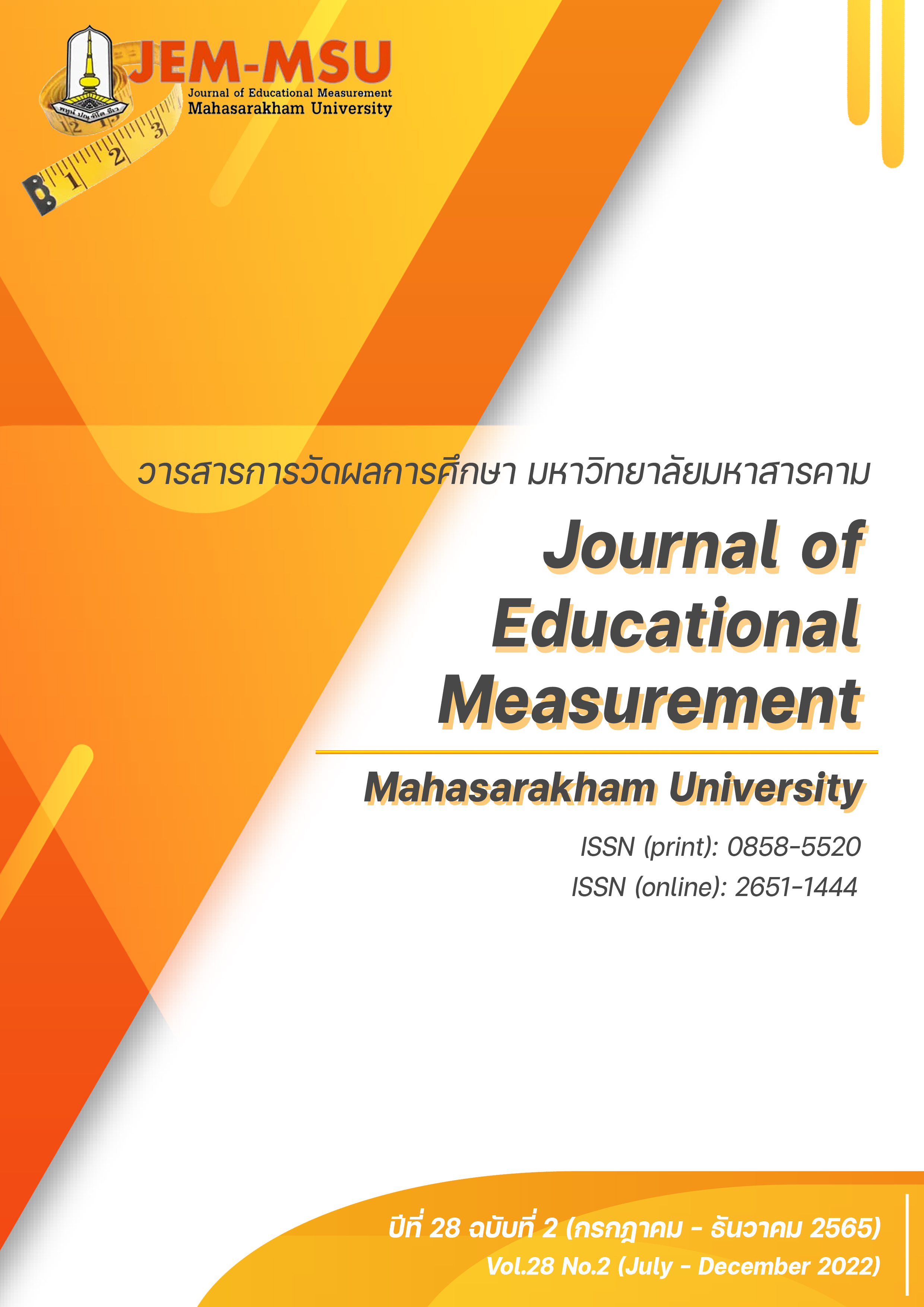การพัฒนาแบบวัดบุคลิกภาพห้าองค์ประกอบสำหรับนิสิตปริญญาตรีชั้นปีที่ 4 มหาวิทยาลัยศรีนครินทรวิโรฒ
Main Article Content
บทคัดย่อ
งานวิจัยนี้มีวัตถุประสงค์เพื่อ 1) พัฒนาแบบวัดบุคลิกภาพห้าองค์ประกอบสำหรับนิสิตปริญญาตรี ชั้นปีที่ 4 มหาวิทยาลัยศรีนครินทรวิโรฒ และ 2) เพื่อตรวจสอบคุณภาพด้านความเที่ยงตรง ความเชื่อมั่น และอำนาจจำแนกของแบบวัดบุคลิกภาพ 5 องค์ประกอบ กลุ่มตัวอย่างได้แก่ นิสิตปริญญาตรีชั้นปีที่ 4 มหาวิทยาลัยศรีนครินทรวิโรฒ ภาคการศึกษาที่ 1 ปีการศึกษา 2562 จำนวน 425 คน ใช้การสุ่มแบบหลายขั้นตอน เครื่องมือในการวิจัยคือ แบบวัดบุคลิกภาพห้าองค์ประกอบมีลักษณะเป็นมาตรประมาณค่า 5 ระดับ จำนวน 60 ข้อ ตรวจสอบคุณภาพด้านความเที่ยงตรงเชิงเนื้อหา นำแบบวัดไปทดลองใช้ แล้วหาค่าอำนาจจำแนกรายข้อโดยการหาค่าสหสัมพันธ์ระหว่างคะแนนรายข้อกับคะแนนรวมที่ปรับแก้ และหาค่าความเชื่อมั่นโดยการหาค่าสัมประสิทธิ์แอลฟาของครอนบาค วิเคราะห์องค์ประกอบเชิงยืนยันด้วยโปรแกรม LISREL Version 8.7 ผลการวิจัยพบว่า
1. แบบวัดบุคลิกภาพห้าองค์ประกอบสำหรับนิสิตปริญญาตรีชั้นปีที่ 4 มหาวิทยาลัยศรีนครินทรวิโรฒ มีองค์ประกอบ 5 ด้าน คือ การแสดงออกอย่างเปิดเผย การเปิดรับประสบการณ์ เข้ากับผู้อื่นได้ดี มีจิตสำนึก รับผิดชอบ และความหวั่นไหว องค์ประกอบแต่ละด้านมีข้อคำถาม 12 ข้อ รวมข้อคำถามทั้งหมด 60 ข้อ
2. คุณภาพด้านความเที่ยงตรงเชิงเนื้อหาได้ค่า .67-1.00 โดยองค์ประกอบ 5 ด้าน คือ การแสดงออกอย่างเปิดเผย การเปิดรับประสบการณ์ เข้ากับผู้อื่นได้ดี มีจิตสำนึก รับผิดชอบ และความหวั่นไหว มีค่า IOC เท่ากับ 1.00, 1.00, .67-1.00, .67-1.00 และ 1.00 ตามลำดับ มีค่าความเชื่อมั่นอยู่เท่ากับ .82, .80, .63, .85 และ .69 ตามลำดับ และค่าความเชื่อมั่นของแบบวัดทั้งฉบับมีค่า .91 และมีค่าอำนาจจำแนกรายข้อ มีค่า 0.203 - 0.605
3. ค่าความเชื่อมั่นในการวัดตัวแปรแฝงอยู่ในระดับที่เชื่อถือได้ โดยมีค่าเฉลี่ยของความแปรปรวนที่ถูกสกัดได้อยู่ระหว่าง 0.466 - 0.483 และมีค่าความเชื่อมั่นในการวัดตัวแปรแฝงอยู่ระหว่าง 0.391 - 0.447
4. ผลการวิเคราะห์องค์ประกอบเชิงยืนยันอันดับสองของโมเดลการวัดบุคลิกภาพ 5 องค์ประกอบ พบว่า โมเดลการวัดตามทฤษฎีมีความสอดคล้องกับข้อมูลเชิงประจักษ์ โดยพบว่าค่าไคแสควร์ () เท่ากับ 228.18, df = 1693, p=1.00, RMSEA = 0.000, NFI=0.79, SRMR =0.018, GFI=0.98
Article Details

อนุญาตภายใต้เงื่อนไข Creative Commons Attribution-NonCommercial-NoDerivatives 4.0 International License.
เนื้อหาและข้อมูลในบทความที่ลงตีพิมพ์ในวารสารการวัดผลการศึกษา มหาวิทยาลัยมหาสารคาม ถือเป็นข้อคิดเห็นและความรับผิดชอบของผู้เขียนบทความโดยตรง ซึ่งกองบรรณาธิการวารสาร ไม่จำเป็นต้องเห็นด้วย หรือร่วมรับผิดชอบใดๆ
บทความ ข้อมูล เนื้อหา รูปภาพ ฯลฯ ที่ได้รับการตีพิมพ์ในวารสารการวัดผลการศึกษา มหาวิทยาลัยมหาสารคาม ถือเป็นลิขสิทธิ์ของวารสารการวัดผลการศึกษา มหาวิทยาลัยมหาสารคาม หากบุคคลหรือหน่วยงานใดต้องการนำทั้งหมดหรือส่วนใดส่วนหนึ่งไปเผยแพร่ต่อหรือกระทำการใดๆ จะต้องได้รับอนุญาตเป็นลายลักษณ์อักษรจากวารสารการวัดผลการศึกษา มหาวิทยาลัยมหาสารคาม ก่อนเท่านั้น
เอกสารอ้างอิง
Adam, U. (2014). The validity and reliability study of the Turkish version of Quick Big Five Personality Test. The Journal of Psychiatry and Neurological Sciences, 27, 316-322. Https:// DOI: 10.5350/DAJPN2014270405
Bollen, K.A. (1989). Structural Equations with Latent Variables. https://onlinelibrary.wiley.com/doi/book/10.1002/9781118619179
Costa, P. T. Jr., & McCrae, R. R. (1992). Revised NEO Personality Inventory (NEO-PI-R) and NEO Five-Factor Inventory (NEO-FFI) professional manual. Psychological Assessment Resources.
Ding, L., Velicer, W., & Harlow, L. (1995). Effect of estimation methods, number of indicators per factor and improper solutions on structural equation modeling fit indices. Structural Equation Modeling, 2, 119-143. doi:10.1080/10705519509540000
Ebel, R. L. & Frisbie, D. A. (1991). Essentials of Educational Measurement. Englewood Cliffs. Prentice-Hall Inc.
Glen, S. (2021). Cronbach’s Alpha: Simple Definition, Use and Interpretation. https://www.statisticshowto.com/probability-and-statistics/statistics-definitions/cronbachs-alpha-spss/
Goffin, R. D. (2007). Assessing the adequacy of structural equation model: Golden rules and editorial policy. Personality and Individual Differences, 42: 831-839.
Hall, C. S., Lindxzey, G., & Campbell, J. B. (1997). Theories of Personality (4th Ed.). Wiley.
Kline, B. R. (2011). Principles and practice of structural equation modeling (4th Ed.). The Guilford Press.
Lemeshow, S., Howmer Jr DW., Klar J. and Lwanga SK. (1990). Adequacy of sample size in health studies. John Wiley & Sons Ltd.
McCrae, R. R., & Costa, P. T., Jr. (1989). The structure of interpersonal traits: Wiggins's circumplex and the Five-Factor Model. Journal of Personality and Social Psychology, 56, 586-595.
McCrae, R. R., & John, O. P. (1992). An introduction to the five-factor model and its applications. Journal of Personality, 60(2), 175–215. https://doi.org/10.1111/j.1467-6494.1992.tb00970.x
McCrae, R. R., & Allik, J. (2002). The Five-Factor model of personality across cultures. Kluwer Academic/Plenum Publishers. https://doi.org/10.1007/978-1-4615-0763-5
McCrae, R. R., & Costa, P. T., Jr. (2002). Personality in Adulthood: A Five-Factor Theory Perspective. http//: DOI: 10.4324/9780203428412
McCrae, R. R., & Costa, P. T., Jr. (2003). Personality in adulthood: A five-factor theory perspective (2nd ed.). Guilford Press. https://doi.org/10.4324/9780203428412
Schumacker, R. E. & Lomax, R. G., (2010). A beginner’s guide to structural equation modeling (3rd ed.). Lawrence Erlbaum Associates
Steiger, J. H., (2007). Understanding the limitation of global fit assessment in structural equation modeling. Personality and Individual Differences, 42, 893-898.
Angsuchot, S., Wichitwanna, S., Pinyopanuwat, R. (2011). Analytical Statistics for Research in Social Sciences and Behavioral Sciences: Techniques for Using LISREL Program (3rd ed.). Charoendee Munkong printing. (in Thai)
Chaiso, P. (2002). Teaching Document 153521 Principles of Measurement and Evaluation of Higher Education. Faculty of Education, Kasetsart University. (in Thai)
Joralee, T. (2015). Big Five Personality Traits, Adversity Quotient, and Perceived Organizational Citizenship Behavior of Employees in a Small Power Producer Group [Master’s thesis]. Thammasat University. (in Thai)
Kaewkangwan, S. (2015). Contemporary personality psychology and psychotherapy. Moh-Chao-Ban Publishing House. (in Thai)
Kaewkangwan, S. (2019). Theory of personality psychology (Knowing Me-Knowing You). (18th Ed.). Moh-Chao-Ban Publishing House. (in Thai)
Kajornsilp, B. (2000). Methods of research in education (5th ed.). P.N. Printing Publishing House. (in Thai)
Kanchanawasee, S. (2013). Classical Test Theory (7th ed.) Printing House of Chulalongkorn University. (in Thai)
Lorwattanawong, K. (2004). A comparative study of the five components of personality. Golman's emotional quotient and Job satisfaction of hotel sales operators in Bangkok [Master’s thesis]. Thammasat University. (in Thai)
Nakapong, N. (2016). The creation and development big five factors personality test for students in elementary and secondary education. The National Institute of Educational Testing Service (Public Organization)
Mohthong, P., Thongkot, W., Ungpansatwong, S. (2010). Determining the Sample Size by the Yamane’s Formula. http://sc2.kku.ac.th/stat/statweb/images/Eventpic/60/Seminar/01_9_Yamane.pdf (in Thai)
Phakprapai, C. (2017). The Study of the Relationship of Leadership Styles, Guide Attributes and the Performance Competency of Professional Tour Guides in Thailand [Master’s thesis]. Mahasarakham University. (in Thai)
Sabaiying, W. (1999). Goal Setting Factor, Self Awareness and Personality Affecting the Performance of the Supplier [Doctoral dissertation]. Srinakharinwirot University. (in Thai)
Saiyot, L. & Saiyot, A. (2000). Psychometric Measurement. Suwiriyasan. (in Thai)
Smithikrai, C. (2007). Personality traits predicting counterproductive work behavior. Department of Psychology. Faculty of Humanities, Chiang Mai University. (in Thai)
Smithikrai, C. (2008). Translation of the NEO-FFI personality test into Thai. Department of Psychology. Faculty of Humanities, Chiang Mai University. (in Thai)
Srisa-ard, B. (2011). Preliminary Research (9th ed.). Suwiriyasan Publishing House. (in Thai)
Wanichthanom, R., Kajornmanee, S., Thongyookong, W., Lekwat, T., and Netranun, T. (2017). Is the Five Component Personality Model applicable in Thai culture? Journal of the Association of Researchers, 22 (2), 165-175. (in Thai)
Wiratchai, N. (1999). Lisrell Model: Analytical Statistics for Research (3rd ed.). Printing house of Chulalongkorn University. (in Thai)


